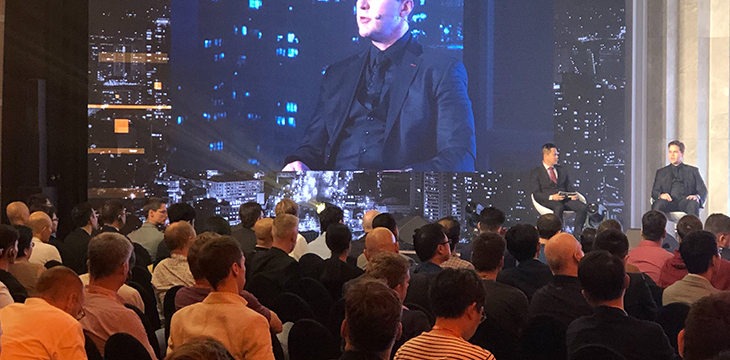Craig Wright fireside chat at CoinGeek Seoul reveals more of Satoshi’s chronicles
The sequel to the Fireside chat aptly titled The Satoshi Chronicles: Part II, with Bitcoin Association Founding President Jimmy Nguyen and Dr. Craig S. Wright at the CoinGeek Seoul Conference, revealed a more emotional side of the man behind Satoshi Nakamoto. The chat reiterated Dr. Wright’s original vision for Bitcoin and what ultimately led him to a lengthy hiatus from the Bitcoin community.
Nguyen wasted no time and continued a conversation that started from the CoinGeek Toronto Conference. He started by asking Dr. Wright, “Why did you choose a Japanese name?” Dr. Wright responded, “When I grew up in the 90s, Japan was the big new thing. Everyone thought that Japan was going to overtake the U.S.”
He added more reasons why he chose the pseudonym Satoshi Nakamoto. His main inspiration was the philosopher Tamasu Nakamoto, who had a lot of ideas about immutability and how to capture truth in a way that wouldn’t change. He used Satoshi because it meant “intelligent history” and when put together, Satoshi Nakamoto was a way of saying Satoshi solving Nakamoto’s problem.
Moving on, Nguyen and Dr. Wright examined early Satoshi writings that have been scrutinized over and over again—emails, posts and archives online. In a post dated January 3, 2009, Dr. Wright posted a headline titled, “Chancellor on brink of second bailout for banks,” on Bitcoin’s Genesis block. Nguyen asked Dr. Wright if he was trying to send a message about Bitcoin at the time, to which he responded, “I want business to work and file on its own. Banks shouldn’t be bailed out. They shouldn’t get special privileges when they fail.”
He also talks about the whitepaper and the most common things people misunderstand and ignore, starting with digital signatures. Dr. Wright expressed that it was important for him to define Bitcoin as a chain of digital signatures because, in common law, it is also allowed to act as a way to transfer goods and services and to bind contracts. “We have all these rules that legalize Bitcoin and act within the law,” Dr. Wright added.
Dr. Wright continued to discuss documents dated years ago about the fundamental pillars of Bitcoin, such as a stable protocol, scalability, simplified payment verification, and micropayments.
In a post dated December 5, 2010, Satoshi appealed to not allow Wikileaks to use the Bitcoin blockchain. Dr. Wright believes, Julian Assange, founder of Wikileaks, dumped information that put people at risk. “There’s disclosure and then there’s responsible disclosure,” added Dr. Wright.
Dr. Wright created Bitcoin as an “honor system.” Not for facilitating drugs, and other “evil things” such as pedophilia, arms trafficking, and illegal activities. Since the early days of Bitcoin, Dr. Wright has always wanted everyone to build applications that would positively impact people, instead, he admits, the very first commercial application that was built by someone on Bitcoin was, unfortunately, a heroin store, which eventually led to the creation of the Silk Road, an online black market.
To help combat this, Dr. Wright helped build software that tracked criminal organizations, however, he still felt his whole life’s work was being put to waste. So, Dr. Wright, the man behind Satoshi Nakamoto, went on hiatus because he was “incredibly disillusioned.”
Dr. Wright felt responsible and very remorseful for the casualties caused by the products sold on the Silk Road, to which Nguyen, comfortingly said, “I’m going to tell you, my friend, it’s not your fault.” Nguyen pivoted and asked Dr. Wright, “What do you want people, developers, and businesses to build with Bitcoin?”
“Fraud, one of the worst things that divide and suck away society, can be minimized.” Dr. Wright wants to see big banks and consultants to not tell you what you did wrong, but tell you what to do right. He asks the audience to imagine a world where fraud and crime are minimized and the positive effects that would have on society. “We’re in a world of 2% growth, imagine if suddenly 15% magically appears. What the hell would that be like? I’d like to think that would be good,” Dr. Wright added.
Dr. Wright concluded his fireside chat by emotionally thanking CoinGeek founder Calvin Ayre for “putting up” with him. “Calvin’s been a mentor. I haven’t always been the best leader or boss or anything like that and I’ll tell my staff and everyone who works with me, thank you for helping develop me,” he said.

After Dr. Wright’s fireside chat, David Case, Chief Architect of Kronoverse, thought Dr. Wright was “insightful and very honest.” He said, “It was refreshing to hear his views in a historical context.”
Hayato Kameta, Zweispace Founder and CEO, added that he gained a deeper understanding from Dr. Wright’s “explanation about what happened in 2010.”
New to blockchain? Check out CoinGeek’s Blockchain for Beginners section, the ultimate resource guide to learn more about blockchain technology.








